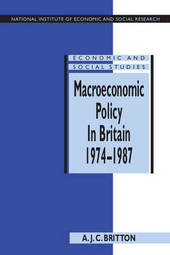
|
Macroeconomic Policy in Britain 1974-1987
Hardback
Main Details
| Title |
Macroeconomic Policy in Britain 1974-1987
|
| Authors and Contributors |
By (author) Andrew J. C. Britton
|
| Series | National Institute of Economic and Social Research Economic and Social Studies |
|---|
| Physical Properties |
| Format:Hardback | | Pages:386 | | Dimensions(mm): Height 229,Width 152 |
|
| Category/Genre | Macroeconomics |
|---|
| ISBN/Barcode |
9780521410045
|
| Classifications | Dewey:339.5/0941/09047 339.0941 |
|---|
| Audience | | Tertiary Education (US: College) | | Professional & Vocational | |
|---|
|
Publishing Details |
| Publisher |
Cambridge University Press
|
| Imprint |
Cambridge University Press
|
| Publication Date |
25 July 1991 |
| Publication Country |
United Kingdom
|
Description
This book is a survey of macroeconomic policy in Britain in the 1970s and 1980s, a subject at the centre both of political debate, and professional controversy, and argues that there were important elements of continuity in the way decisions were actually taken year-by-year and month-by-month in the Treasury and the Bank of England in this period. It is written by Andrew Britton, the director of the National Institute of Economic and Social Research, and previously a senior economist at the Treasury, and is a sequel to the NIESR studies by Christopher Dow, (1945-1960), and by Frank Blackaby and others (1960-74). Part One is a chronological account of policy actions and their setting. Part Two provides a history of ideas, describing the most influential writings of economists in Britain during this period, while Part Three looks at the influence of the world economy on Britain. Parts Four and Five include several elements of new statistical analysis concerning the way in which policy instruments were used, in particular the signals to which policymakers reacted when setting interest rates. The effects of policy actions are estimated using the Institute's macroeconomic model. Amongst the other issues addressed are: the consequences of floating exchange rates; the reasons for the upward trend in unemployment; the relationship between money and prices; and the effects of fiscal and monetary policy on the growth potential of the economy. A full calender of events and an annotated bibliography are included as further aids to the reader.
|